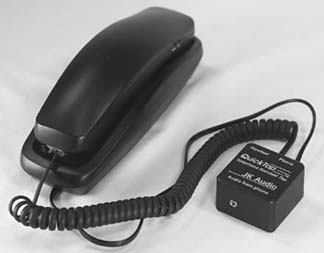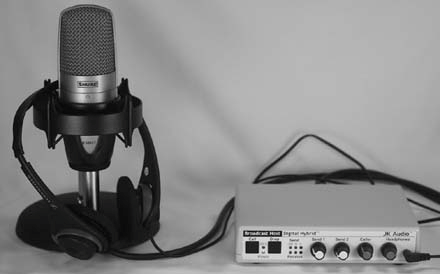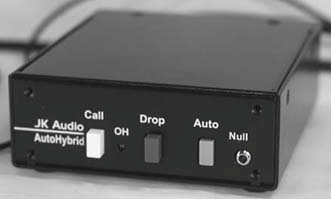Hack34.Record Telephone Interviews HACK
Hack 34. Record Telephone Interviews HACK
Use hardware and software solutions that will give your phone interview a quality that is similar to what you would get in person. When you can't get face to face with your subject for financial or scheduling reasons, your best bet is to interview him over the phone. This hack covers the legal issues and gives some technical solutions to get reasonable sound quality for remote interviews.
5.3.1. Handset TapYou can record a conversation over the phone in several ways. The simplest is the handset tap. This device fits between the phone and the corded handset. You disconnect the handset and connect the tap in its place. Then you connect the handset to the tap. Next, using a microphone cable, you connect the tap to the microphone input on your computer or recording setup [Hack #12]. These are relatively inexpensive devices. The one shown in Figure 5-1, the QuickTap from JK Audio (http://jkaudio.com/quicktap.htm), costs around $60. The audio recorded from taps is good enough for podcasting work. The downside of using a tap is that you cannot use your studio microphone in this setup. Also, the interviewer and interviewee's voices are mixed together on the same channel. Figure 5-1. A handset tap from JK Audio 5.3.2. CouplerA step up from the handset tap is the coupler, which fits between the phone and the wall jack. Couplers work like taps, but they have the additional feature of allowing output from the computer to be injected into the conversation through an input port. Couplers are also handy when you don't have a corded handset to connect to. The coupler shown in Figure 5-2 is the Voice Path (http://www.jkaudio.com/voice-path.htm) from JK Audio. It costs around $110. The same disadvantages apply to the coupler as to the handset tap. Though in addition, you cannot use the coupler on multiline installations or on Voice over IP (VoIP) systems. However, a handset tap works in almost any situation. 5.3.2.1 Uncle Doug's hack.Doug Kaye, over at IT Conversations (http://itconversations.com/), recommends using two telephone lines and a coupler. The first line has the coupler attached and is the one you record off of. You speak into the second line. When you have all three conferenced together, you will sound remote, just like the person you are talking to. This eliminates some of the volume issues associated with couplers Figure 5-2. A coupler from JK Audio 5.3.3. Telephone HybridAt this point, you might be asking how your local radio shows do telephone call-ins, since those calls sound good and the announcer's voice is obviously coming through the studio microphone. They use a telephone hybrid. And in recent years, the cost of these hybrids has come into the affordable range for podcasters. The Broadcast Host, shown in Figure 5-3, costs $495 and is available from JK Audio (http://www.jkaudio.com/broadcast-host.htm). The company also offers a lower-end version called the AutoHybrid (http://www.jkaudio.com/autohybrid.htm), which is shown in Figure 5-4 and retails for $175. Hybrids fit between the wall jack and the phone. They have an output for the sound of the caller and an input for the sound of the microphone [Hack #13]. These inputs are usually XLR jacks suitable for use with a mixer or preamp. Figure 5-3. The Broadcast Host telephone hybrid Figure 5-4. The AutoHybrid telephone hybrid To receive a call with a hybrid, just use the call button to take the call off the hook. You will hear the caller in your headphones and be able to talk with him through your microphone. To start a call, you use your handset to dial and then you press the call button to take the hybrid off the hook. Next, hang up the handset and communicate using your microphone and headphones. Of all the options I will present in this hack, the hybrid offers the highest sound quality and the most control. You can have the hybrid mix signals into a single channel for recording, or you can record both interviewer and interviewee on separate channels. The two-channel recordings allow for maximum flexibility. 5.3.4. Record Through a ModemCall Corder (http://callcorder.com/callcorder.htm), $49.95, and Modem Spy (http://www.modemspy.com/), $24.95, are Windows applications that record audio from the phone line using an internal or external modem that supports voice mode. Using a Y connector, you attach a handset to the modem, then you dial manually or have the computer do it for you, and you talk over the phone as you normally would. The software records the conversation to an audio file. On the Macintosh, the voice modem-recording situation is not so good. OS 9 and earlier versions allowed you to use the modem audio as an input channel for recording. Unfortunately, Mac OS X has not allowed for this as of this writing. So, while it is possible to take the modem off-hook indefinitely and to hear the audio through your system speakers, it is not possible to record that audio internally. 5.3.5. Teleconferencing SystemsAnother option is to use one of the many teleconferencing services available on the Internet. An example of this is Conference Call (http://conferencecall.com/). When you sign up, you will get access to a phone number that all your participants can call. You can request that the conversation be recorded and that the recording be sent to you. Editing these types of recordings is limited because the sounds of all the callers will be mixed equally in stereo. 5.3.6. Conference Calling Your BlogAudioblogger [Hack #38] (http://audioblogger.com/) can record podcasts from a phone call. You can use this feature to record your interviews. Using the conferencing feature on your phone, you call the interviewee and your Audioblogger account, and then conference the two together. Once the call is over, Audioblogger will post a link to the audio in your blogger account. Then you can download the file to your machine, make any edits you please, and post it on your blog in its finished form. As with the other teleconferencing solutions, the audio will be mixed together across the mono or stereo signal. This will reduce your ability to make edits exclusive to an individual participant. Audioblog (http://www.audioblog.com/) also supports this feature and works with a variety of different blogging packages. 5.3.7. Cell PhonesIn a pinch, you can use the call-recording feature on a cell phone to record a call. However, the space is usually limited and the quality of the recording is very low. Use the Bluetooth, infrared, or Universal Serial Bus (USB) cable support on your phone to download the recorded conversation to your computer. 5.3.8. Recording the SpeakerphoneIf all you want is the voice for dictation purposes and you have no hardware to speak of, you can record a speakerphone. Use the internal microphone on your computer to record while you talk over the speakerphone. Be sure to turn off the speaker on the computer to avoid feedback. Keep the computer relatively close to both you and the phone. And turn the volume on the phone to its highest level before it starts to distort. If you have a good omnidirectional microphone on hand, you can place it between you and the speakerphone. If the speakerphone has reasonable sound, you should be able to get a signal quality that approaches that of a teleconferencing system. 5.3.9. SkypeStill another option is to get away from phones altogether and use the Skype service [Hack #35] to make and record calls. 5.3.10. Two-EndersEven the best recordings of phone interviews can be difficult to listen to. A phone line removes components below and above the content portion of the voice's tonal spectrum. Unfortunately, the removed sections add depth and character to the sound of our voices, so we end up sounding very grating and harsh. All of us have learned to live with it out of necessity, but when we listen to a whole interview conducted over the phone, it can get so bad that even with the most interesting content it becomes something we want to turn off. Broadcasters have been dealing with this problem for years and have developed a simple solution. It's called a tape sync or a two-ender. The idea is simple. You have your phone conversation as you normally would, but at both ends you also record the conversation with a high-quality microphone [Hack #13] and recorder [Hack #69]. Then the interviewee sends the interviewer his side of the conversation using email or FTP. On the editing side, the interviews are placed in different tracks, and the alignment is adjusted until the interview questions and responses line up properly. In the old days, when recording was done on tape, getting the two conversations to line up could be problematic. The tape would stretch, or one tape would run slightly faster or slower than the other would. Now, with digital recording, it's easy to get the two conversations to line up. Though in practice, the 44.1 kHz rate on one recorder is not the same as the 44.1 kHz rate on another, so over a long interview you will have to do some manual addition or subtraction of silence in one signal or the other to line them up. If the person you are interviewing has a decent microphone and a computer or portable recorder, this should not be a problem to set up. If he doesn't have a microphone, you have a couple of options. The cheap route is to use Skype or iChat recording [Hack #35], but to have the interviewee use Audio Hijack Pro on his side of the session as well. Then he sends you his file after the interview and you can line up the two. This way, you get a clean microphone sound on both sides of the fence. You record the incoming Skype signal only as a backup. This method will scale to multiple participants in a Skype conference call, but lining up each signal is more time consuming. If you have the money and you are serious about getting a high-quality sound, you can also hire an independent recordist to go on location to record your interviewee while you talk with her on the phone. The recordist sends you the file with the high-quality sound. You can find independent recordists through your local public radio affiliate. 5.3.11. ISDNIf you have the money and the time, you can use ISDN [Hack #61] to get professional quality for your remote interview. Broadcast studios have ISDN lines to each booth and you can rent an hour or two in the booth at your local station and at a remote station if you know to request the rental of a broadcast booth with ISDN access. It will be expensive, but the sound quality will be spotless. 5.3.12. See Also
|
EAN: 2147483647
Pages: 144